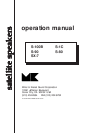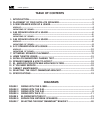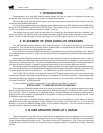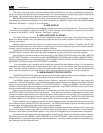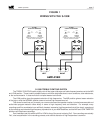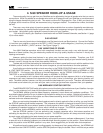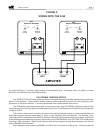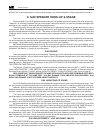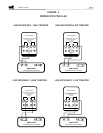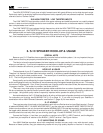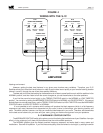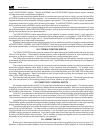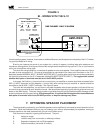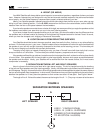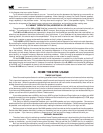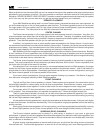
satellite speakers
page 8
actually "flat", due to equalization in the recording process, and artificial alteration of high frequencies is common.
5. S-80 SPEAKER HOOK-UP & USAGE
The back panel of your S-80 speakers contains two pairs of speaker terminals (instead of the usual single pair).
Therefore it is extremely important that you follow these instructions carefully, to avoid any possible damage to the
speakers or your amplifier, and to get the best possible sound.
The sound quality that you get from your Satellites can be affected by the type of speaker wire that you use to
connect them. While it is possible to use speaker wire as thin as 22 gauge to hook your Satellites up, we recommend
using the largest diameter wire that you can. This means a minimum of 18 gauge wire. Over 10 feet, you should use
16 gauge, and for more than 30 feet, we recommend using 14 gauge or heavier. The smaller the number, the thicker
the wire.
There are a very wide variety of premium speaker cables available from a number of specialist manufacturers.
We do not endorse any specific brand of premium cable, but we do recommend using as high quality a cable as fits
your budget. Using better quality cables will improve the sound of your Satellites.
M&K Satellites are not designed for bi-wiring. Do not use the four input terminals to bi-wire your Satellites, as this
may damage your amplifier and speakers. If you wish to bi-amplify your Satellites in combination with an M&K Powered
Subwoofer, see Section 11 (page 18) for more details.
S-80 HOOKUP
There are two pairs of terminals on the backplate. Depending on which combination of the four terminals you use
to connect your amplifier, you can alter the tonal quality of your S-80 speakers to better match your room, electronics,
or personal preference.
These "Variations of Sound" let you achieve much smoother and flatter frequency response in your room, at your
listening position. See below for a discussion of the HIGH EFFICIENCY/LOW EFFICIENCY inputs and the HIGH
TWEETER/LOW TWEETER inputs.
The Positive (+) lead from your amplifier or receiver should be connected to one of the RED (+) INPUT terminals
(either HIGH TWEETER / LOW TWEETER), and the Negative (-) lead from your amplifier or receiver should be
connected to one BLACK (-) INPUT terminal (HIGH EFFICIENCY / LOW EFFICIENCY). See Figure 3 (page 9).
VERY IMPORTANT: NEVER CONNECT THE AMPLIFIER LEADS TO BOTH RED TERMINALS OR TO BOTH
BLACK TERMINALS AT THE SAME TIME. YOU MAY DAMAGE YOUR AMPLIFIER AND SPEAKERS. ANY
RESULTING DAMAGE IS NOT COVERED UNDER WARRANTY.
S-80 VARIATIONS OF SOUND
Your S-80 Satellites reproduce sound with exceptional transient accuracy and a very wide dynamic range. They
will give you give outstanding results with any high quality amplifier or receiver in virtually any listening environment.
However, getting the best tonal balance in any given room involves many variables. Therefore, your S-80
Satellites allow you to alter their tonal balance in order to get the ideal sound quality at your favorite listening location
(where it counts!), by using one of four combinations of input terminals to connect the speakers to your amplifier.
The inputs are labelled HIGH EFFICIENCY and LOW EFFICIENCY. Both positions have the same power
handling capacity, but the HIGH EFFICIENCY position plays the loudest, and works best with low powered amplifiers.
Bear in mind that the HIGH EFFICIENCY input requires a higher setting of the subwoofer level. Conversely, if
you switch to the LOW EFFICIENCY input, the subwoofer level should be set lower.
We recommend that you experiment with the inputs, starting out by using the HIGH EFFICIENCY and HIGH
TWEETER input terminals. If the sound is too bright or harsh-sounding, try switching to the LOW TWEETER input. If
it still seems too bright, try the LOW EFFICIENCY input with either HIGH TWEETER or LOW TWEETER.
There is no single ideal or "flat" input combination, because we cannot predict in advance exactly what response
will produce that in your room. The choices available through the inputs, however, can allow you to create a virtually
ideal response for your room. Hence, you should use the inputs that best balance the sound for your ears and your
room, so that you get maximum enjoyment from your speakers.
S-80 HIGH EFFICIENCY / LOW EFFICIENCY INPUTS
The LOW EFFICIENCY input gives a very warm "laid-back" midbass sound with subdued or recessed midrange.
Even though it is very similar in character to the finest British-manufactured monitor speakers, it has a significantly wider
dynamic range. Sometimes referred to as the "English Sound."



